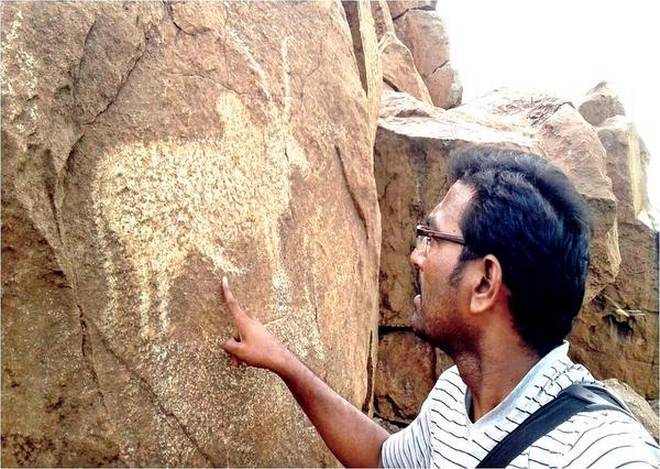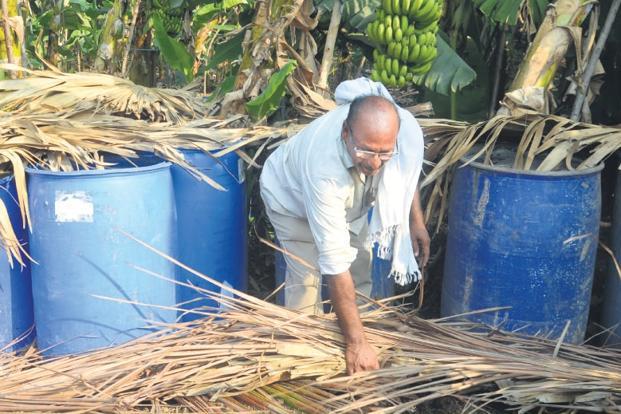Monthly Archives: June 2018
22
21st
State’s largest petroglyph site discovered at Kandanathi

It dates back to Mesolithic, Neolithic, and pre-historic periods, says researcher of Yogi Vemana University
Kandanathi, a tiny village located about 5-km south of Yemmiganur mandal headquarters in the district, is the biggest petroglyph site in Andhra Pradesh, an exploration by an archaeology researcher of Yogi Vemana University has revealed.
The petroglyphs had attracted the attention of scholars in 2015-16. But no extensive study was made until Yadava Raghu, an academic consultant in the History and Archaeology Department of Kadapa-based Yogi Vemana University, surveyed them.
Dr. Raghu discovered rock art with engravings, and peckings and bruisings, predominantly of humped bulls and also of human figures, at Kandanathi dating back to the Mesolithic, Neolithic, and pre-historic periods.
“Kandanathi has the first biggest explored petroglyph site in the State with the detection of nearly 200 engravings, peckings and bruisings,” Dr. Raghu told The Hindu.
“Maximum depictions are outlined. A few are flat wash, and the depicted figures are that of a tiger, streak of tigers, leopards, camels, bulls, elephants and horses, scenes of riders on bulls, camels and horses, hunting scenes with bow and arrow, sword and dagger etc.,” he explained.
Carnival scene
There was a carnival scene with humans playing musical instruments such as ‘dolu’ and ‘kommu’, he said.
There were several depictions of bulls with various sizes of horns and humps, and in association with riders.
“An uncanny one is that of a robust bull in flat wash measuring 50 cm in height and 50 cm in length with a high hump and an erected organ, which dates back to the Neolithic and pre-historic periods,” Dr. Raghu said.
In addition, there were plenty of figures of animals and humans drawn on boulders such as goats, monkeys, dogs etc.
“Kandanathi is located at the foot of a hillock, locally called Nalla Kondalu, having hummocky masses varying from large blocks to boulders on which petroglyphs were depicted, and most of them are facing east,” he explained.
“The peak of the hillock has remains of a mutilated “buruju,” possibly dating to the Vijayanagara period (1336-1670 AD),” he said.
One grinding hole was noticed on the foothill located at a distance of 10 metres from the site towards the west. The rock art in the village comprised paintings/pictographs and petroglyphs.
Dr. Raghu asserted that the earliest discovery of petroglyphs (bruising) was on the Kupgallu Hill in Bellary district of Karnataka by Fawcett in the year 1892. Later, Bruce Foote had discovered some more bruisings and engravings at the Kupgallu Hill site, he said.
“An evidence of the activities of early humans and their cultural continuity are copious in the Rayalaseema region,” he said.
“Kurnool district is one of the richest zones of the prehistoric centres in the world for early human activities, and throws valuable insight into the past culture and cultural continuity to the archaeologists,” he added.
Kandanathi is surrounded by brooks namely Banavasi Vanka, Eerlaiah Sami Vanka, Giddaiah Vanka. and Yenkanna Vaagu, which ultimately join the Handri, a tributary of the Tungabhadra.
“The petroglyphs at Kandanathi reveal the presence of the Boya community divided into many exogamous groups such as Mandla (herdsmen) and Yenubothula (buffalomen).” he observed.
source: http://www.thehindu.com / The Hindu / Home> News> States> Andhra Pradesh / by M.V. Subramanyam / Kurnool – June 18th, 2018
19
18
17
16
How Andhra Pradesh is taking to ‘natural farming’
ZBNF is considered ‘zero budget’ because costs of raising the main crop are offset by the income that farmers earn from intercrops.

Vijaywada/New Delhi:
About three years ago, Pawan Kumar, working as an IT professional at Hyderabad, decided to quit his job and return to his village to become a farmer. His father, a small farmer in West Godavari district, tried to discourage him but Kumar who had read about a new method of “natural farming” would not listen.
“My mother cried a lot… they told me no girl would marry a farmer but I am happy I came back. My father was initially reluctant to let me farm even an acre, but now he has allowed me to convert all five acres to natural farming,” says Kumar, 26.
Kumar is among 163,034 farmers in Andhra Pradesh practising zero-budget natural farming or ZBNF, where chemical fertilizers and pesticides make way for locally available cow dung and cow urine, jaggery and pulse flour. These are used to make a fermented culture which stimulates microbial activity in the soil, promoting better plant growth and protect crops against pest attacks.
Mulching, or covering the top soil with crop residues to increase water retention and supply the soil with essential nutrients; and intercropping, say coconut farms with cocoa or banana plantations with yams and pulses are also integral to ZBNF. The method was pioneered by Subhash Palekar, an agriculturalist from Maharashtra and a Padma Shri awardee from 2016.
On 2 June, the Andhra Pradesh government launched an ambitious scale-up of the ZBNF programme to take it to 6 million farmers by 2024. The programme will be promoted by a specialized wing of the government called Rythu Swadhikara Samstha. An interesting innovation here is that the agency has recruited over 100 natural farming fellows—agriculture graduates who are paid ₹30,000 a month to demonstrate the benefits of ZBNF by taking up farming in rented plots and staying in villages to answer farmers’ queries.
The programme will be financially assisted by the Sustainable India Finance Facility (SIFF)—set up jointly by the United Nations Environment Programme, the World Agroforestry Centre and BNP Paribas—with targeted investments of ₹16,000 crore over the next six years.
“Our core objective is to scale investments in sustainable and climate-resilient agriculture that are transformative at many levels… we believe the target set by Andhra Pradesh is achievable, but this will require creation of a ‘natural farming’ brand to help market the produce and earn a better value for farmers,” said Satya Tripathi, chair of SIFF.
Driven by the promise of ZBNF, N. Satya Narayana, a farmer from Dommeru Village in West Godavari district converted all of his six acres of banana farm to natural farming last year. “Last month when a hailstorm flattened other farms, mine was unaffected as the plants were strong,” Narayana said, pointing to a bunch of bananas which looked fatter than those grown with chemical inputs. However, some farmers Mint spoke to also said that for field crops like paddy, there is an initial drop in yield which they managed to overcome by selling the produce locally at higher prices.
“Costs come down drastically under ZBNF, but some of the savings are used up by the rise in labour costs to prepare Jeevamrutham (fermented microbial culture which is used as the base fertilizer) and other inputs,” said V. Venkataraman, another farmer.
Crop-cutting experiments, which are conducted to assess yields, showed that ZBNF groundnut farmers’ yields from 2017 were 23% higher than non-ZBNF plots, while for paddy, yields were 6% higher, noted a 2018 brief prepared by the Delhi-based Council on Energy, Environment and Water.
“ZBNF is considered ‘zero budget’ because costs of (raising) the main crop are offset by the income that farmers earn from intercrops,” the brief said, adding, “once implemented across all farmlands, ZBNF can have considerable health benefits for over 50 million consumers in the state, who would be able to avoid exposure to inorganic chemicals present in crops.”
“ZBNF makes nutrients locked up in the soil bioavailable.. so consumers find food from natural farming sources to be tastier… studies have shown presence of vitamin B12 in bottle gourd, something the vegetable is never associated with,” said T. Vijay Kumar, adviser, agriculture to the state government and the chief architect of the programme.
But how is natural farming different from organic farming? “In organic and traditional agriculture, cow dung is used as a fertilizer, in ZBNF it is an inoculum… so, dung from one cow is adequate for up to 30 acres,” Kumar adds.
source: http://www.livemint.com / Home> Politics / by Sayantan Beera / June 12th, 2018
City kids to represent India at global skating championship
Vijayawada :
City kids Gummadi Venkata Pardhu and Bathula Sri Vidhya got selected to represent India in World Skate Speed Championship- 2018 which is scheduled to held at the Netherlands from July 1.
Both of them appeared for selections held in Gurgaon and secured their place.
Fourteen-year-old Gummadi Venkata Pardhu who is studying tenth standards in Sri Chaitanya Schools said, “I started skating in a summer camp held in 2012 and later it became my world. I daily practice on BRTS Road from 5am to 7am before going to school and I continue to practice even after classes which helped me learn more techniques.”
“Representing India in the senior category and winning an international medal is my dream and I hope I will achieve it one day,” he added.
“Dedication and commitment of my son helped him to get selected for the international championship under junior category in young age and he broke the record which was on the name of his coach Sarath Kumar,” said Pradhu’s father Durga Kumar. “We are spending a lot of money on training and international tours and we hope that state government and Sports Authority of Andhra Pradesh (SAAP) will recognise my son’s efforts and support him,” he added.
Bathula Sri Vidhya who is studying in twelth standard at Nalanda Vidya Niketan in the city said that she was happy for being the first girl to participate in International Championship from Krishna district.
Support of my school management is unforgettable and they encouraged me very much. Sri Vidhya who got second place in road hundred meters category also got selected for Asian roller skating championship which is scheduled in September.
“Encouragement and support given by my parents and school management helped me in achieving my dream and I want to make my city proud by achieving the international medal for the first time in Andhra Pradesh,” said Sri Vidhya.
source:http://www.timesofindia.indiatimes.com / The Times of India / News> City News> Vijayawada News / by Venu Lanka / TNN / June 14th, 2018